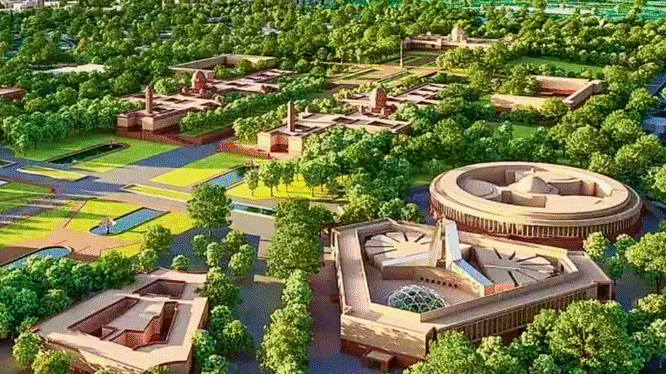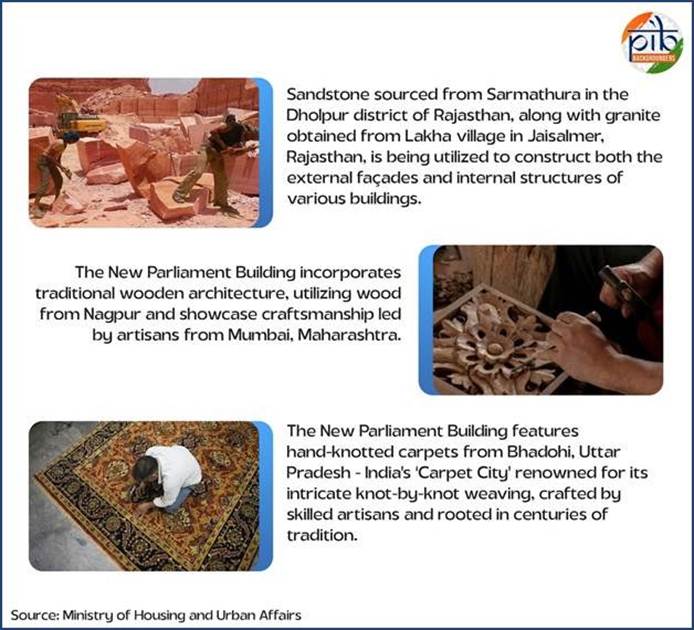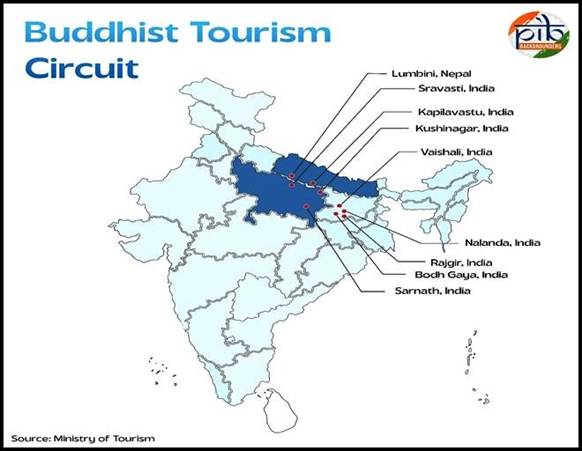Published on Aug 6, 2025
Daily PIB Summaries
PIB Summaries 06 August 2025

Content
- Central Vista Project
- A Joyous Homecoming: India’s Sacred Buddhist Relics Return After 127 Years
Central Vista Project
Context & Background
- Launched: 2020
- Location: New Delhi (spanning India Gate to Rashtrapati Bhavan)
- Executing Agency: Central Public Works Department (CPWD)
- Architect: HCP Design Planning & Management Pvt. Ltd. (led by Bimal Patel)
- Supervising Ministry: Ministry of Housing and Urban Affairs
- Estimated Cost: Approx. ₹13,500 crore (as per public statements)
Relevance : GS 2 ( Polity & Governance ), GS Paper 3 (Infrastructure & Environment)


Constitutional & Governance Significance
- Democratic Symbolism:
- New Parliament building represents the “temple of democracy”.
- From Rajpath (symbol of colonial authority) to Kartavya Path (citizen-centric governance).
- Governance Rationality:
- Integration of 51 Ministries into 10 Common Central Secretariat (CCS) buildings.
- Elimination of dispersed office spaces rented across Delhi → improves inter-ministerial coordination.
- Promotes e-governance via tech-enabled modular buildings.
Key Infrastructure Components
| Component | Function | Status (as of Aug 2025) |
| New Parliament | 888 Lok Sabha seats, 384 Rajya Sabha seats | Completed |
| Kartavya Path | Civic space, ceremonial avenue | Redeveloped |
| Kartavya Bhawan | CCS building for key ministries | To be inaugurated (Aug 6, 2025) |
| VP Enclave | Official Vice President residence & office | Completed |
| National Museum | Conversion of North & South Blocks into museums | Planned |
| CCS 1, 2, 6, 7, 10 | Common Secretariat buildings | Under Construction |
Administrative Gains
- Efficient Resource Use:
- Reduces annual expenditure on government building rentals (~₹1,000+ crore/year).
- Faster Decision-Making:
- Ministries in close physical proximity = enhanced synergy and productivity.
- Digital Governance Hub:
- Buildings equipped with smart tech, high-speed networks, and security systems.
Environmental Impact & Sustainability
- Green Features:
- 40,573 trees to be planted; no existing trees cut.
- Redevelopment of Kartavya Path added 197 new trees (now 4,087 vs earlier 3,890).
- Use of Construction and Demolition (C&D) waste for material recycling.
- Energy Efficiency:
- Kartavya Bhawan to save 30% energy and generate 5.34 lakh kWh annually.
- Promotes non-motorised transport and public transport integration.
- EIA Compliance:
- All sub-projects cleared via rigorous Environmental Impact Assessments.
Cultural & Social Benefits
- Public Space Expansion:
- National Museum, IGNCA, lawns, India Gate plaza → redesigned for public use.
- Democratisation of Space:
- 80,000 sq.m. of historic office space repurposed for citizens.
- Tourism & Heritage:
- Redesigned Kartavya Path integrates pedestrian walkways (16.5 km) and canal restoration.

Economic & Strategic Dimensions
- ‘Made in India’ Focus:
- Indigenous materials and crafts used across structures – boosts local artisans and MSMEs.
- Employment Generation:
- Thousands of direct and indirect jobs created across construction, design, and engineering sectors.
- Long-Term Fiscal Prudence:
- Cuts high maintenance and rental costs of outdated buildings.

Criticism & Debates
- Timing Criticism:
- Project launched amid COVID-19 pandemic; called “misplaced priority” by some civil society groups.
- Transparency Issues:
- Debates on lack of Parliamentary approval and limited public consultation.
- Heritage Conservation vs Modernisation:
- Concerns raised on altering the historical character of Lutyens’ Delhi.
Alignment with Key Government Initiatives
| Initiative | Alignment with Central Vista |
| AatmaNirbhar Bharat | Use of indigenous designs and materials |
| Digital India | Tech-enabled governance structures |
| Swachh Bharat Mission | C&D waste management; green energy systems |
| Ease of Living/Govt. | Integrated public and government spaces |
| Smart Cities Mission | Intelligent infrastructure in administrative design |
Prelims Pointers
- Architect: Bimal Patel
- Executing Body: CPWD under MoHUA
- Location of new Parliament: Adjacent to old Parliament
- Total Ministries: 51 in 10 CCS Buildings
- Renamed Road: Rajpath → Kartavya Path
Conclusion:
The Central Vista Project is not merely an architectural makeover; it is an institutional reimagination of India’s governance structure — combining administrative efficiency, sustainability, heritage conservation, and citizen participation. It exemplifies India’s march towards becoming a 21st-century governance hub aligned with the vision of a New India.
A Joyous Homecoming: India’s Sacred Buddhist Relics Return After 127 Years
Context & Background
- Event: Return of sacred Piprahwa Buddhist Relics to India in July 2025, after 127 years.
- Discovery: In 1898, by British engineer William Claxton Peppé at Piprahwa Stupa (Siddharthnagar, Uttar Pradesh), near ancient Kapilavastu, homeland of Lord Buddha.
- Contents: Included bone relics (believed to be those of Buddha), crystal caskets, gold and gemstone ornaments, and a sandstone coffer.
- Colonial Loss: These sacred relics were taken abroad during the British era; part of them resurfaced in Sotheby’s auction (Hong Kong, May 2025).
- Repatriation: India intervened diplomatically; relics were returned via a public-private partnership between Ministry of Culture and Godrej Industries Group.
Relevance: GS I( Indian art & culture, religious heritage), GS II (Cultural diplomacy)

Historical & Cultural Significance
- Buddha’s Relics: Physical remains of Gautama Buddha hold spiritual and ritualistic sanctity; enshrined post-Mahaparinirvana (483 BCE) by disciples.
- Piprahwa Inscription: Inscription in Brahmi script on relic casket confirms enshrinement by Sakya clan (~3rd century BCE).
- Excavation Timeline:
- 1898: Discovery by Peppé.
- 1971–77: ASI-led excavation unearthed 22 sacred bone relics in steatite caskets.
- Preservation: Some relics have been stored at the National Museum, New Delhi; others were in international possession until now.
Reasons for Relevance in Current Times
- Post-Colonial Cultural Assertion: Part of global trend to reclaim artefacts from colonial-era looting (e.g., Kohinoor, Parthenon Marbles).
- Buddhist Revivalism: Strengthens India’s Buddhist identity for both domestic harmony and international influence.
- Policy Alignment: Reflects PM Modi’s vision of “Vikas Bhi, Virasat Bhi” – fusing economic progress with cultural restoration.
- Cultural Sovereignty: Enhances India’s global standing as authentic custodian of Buddhist heritage.

India’s Buddhist Heritage: Strategic & Civilizational Importance
- Civilizational Role:
- Birthplace of Buddhism.
- Associated sites: Lumbini (Nepal), Bodh Gaya, Sarnath, Kushinagar.
- Spread of Dhamma:
- Emperor Ashoka (3rd century BCE): Propagated Dhamma through edicts, missionaries.
- Growth of Theravada, Mahayana, Vajrayana traditions across Asia.
- Swadesh Darshan – Buddhist Circuit:
- Development of pilgrimage infrastructure.
- Key sites: Kapilavastu, Sarnath, Kushinagar, Vaishali, etc.
- Boosts cultural tourism, regional economy, and pan-Asian Buddhist consciousness.
Cultural Diplomacy & Soft Power
- Strategic Use of Buddhist Diplomacy:
- India leverages Buddhist heritage to strengthen bilateral ties with Buddhist-majority nations.
- Key Recent Cultural Exhibitions:
- Thailand (2023):
- 26-day relic display in 4 cities (Bangkok, Chiang Mai, Ubon Ratchathani, Krabi).
- 4 million+ visitors – deepening spiritual ties.
- Vietnam (2024):
- Held during UN Vesak celebrations.
- Displayed in 4 cities – 17.8 million attendees.
- Mongolia (2022):
- Sacred relics showcased on Buddha Purnima.
- Symbolic of reviving Indo-Mongolian religious ties.
- Thailand (2023):
- Impact:
- Reinforces India’s status as “Cultural and Spiritual Anchor” of Asia.
- Projects India as protector of Buddhist dharma globally.
- Facilitates soft diplomacy rooted in shared civilizational values.

Events & Initiatives to Promote Buddhist Heritage
A. Global Buddhist Summit 2023
- Theme: Universal Values, Peace & Sustainability.
- Inaugurated by PM Modi; participation from major Buddhist nations.
- Emphasized India’s leadership on global ethical and spiritual issues.
B. Asian Buddhist Summit 2024
- Theme: Role of Buddha Dhamma in Strengthening Asia.
- Participants from 32 countries; 160 international delegates.
- Highlighted cultural synergy and peace-oriented diplomacy.
C. Annual Commemoration of Key Buddhist Festivals:
- Vesak Day (Buddha Purnima):
- Celebrates Birth, Enlightenment, and Mahaparinirvana.
- PM Modi’s 2017 visit to Sri Lanka and 2021 keynote during global celebrations emphasized India’s commitment.
- Ashadha Purnima (Dhamma Day):
- Commemorates Buddha’s first sermon at Sarnath (Turning of the Wheel of Dharma).
- 2025 Celebration: Global monastic participation at Mulagandha Kuti Vihara, Sarnath.
- Abhidhamma Day:
- Symbolizes Buddha’s descent from Tavatimsa Heaven to Sankisa (Uttar Pradesh).
- 2024 Event: Held in New Delhi; attended by 1,000+ delegates from 14 countries.
Linguistic & Scriptural Preservation
- Pali Language:
- Declared a Classical Language in October 2024.
- Language of Theravada scriptures; key to preserving Tipitaka and Buddhist philosophical thought.
- Facilitates academic research and scriptural conservation.
Conclusion
- The return of Piprahwa relics is a momentous civilizational milestone, symbolizing:
- Post-colonial restoration of cultural pride.
- Reassertion of India’s Buddhist leadership on the global stage.
- Moral responsibility to reclaim sacred heritage.
- This initiative exemplifies India’s aspiration to become a Vishwa Guru by blending spiritual depth, diplomatic maturity, and cultural stewardship.
